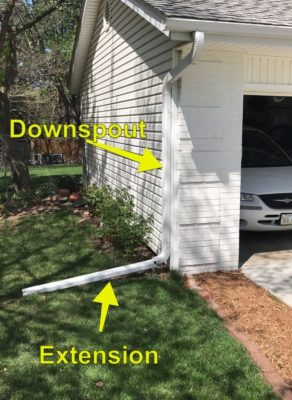The last couple weeks haven’t felt like it, but allegedly it’s spring. That never fails to remind me of my favorite joke, which you’ll have to read to the end to answer: April showers bring May flowers. What do May flowers bring?
April showers bring something else to homeowners: a nature-made test for how functional your gutters are. In the fall, we put together a quick White Castle Roofing guide for what gutters do and why they’re important. As a follow-up, we’d be remiss as a good roofing contractor if we didn’t also emphasize the importance of your downspouts, a critical component of your gutters.

Hallmarks of a good gutter system: effective and inconspicuous!
As you know, your gutters are the receptacles of the April (and May, and June, and October) showers that fall on your roof. But if all your gutters did was collect water, they’d fill up pretty quickly — and so as part of that system, your downspouts are what carries that water away from your home and deposits it safely away from your house’s foundation or basement.
You may not be able to see it easily, but your gutters are hung at the tiniest angle toward your downspouts, typically placed at the corners of your house, and/or about every 40 feet, give or take a bit. Water flows down the roof into the gutters, which drain into the downspout, which uses extensions at the end to send the water to a safe place…like so:

We’ve already been through the importance of keeping your gutters maintained, here and here. A routine inspection — at least once or twice a year, if not more frequently — can help you identify any minor issues before they became major problems. If you’re the DIY type and you’re cleaning your gutters out by yourself, don’t forget to check and clean your downspouts. (If you’d prefer to hire a professional to clean your gutters once to get you started so you can maintain them yourself, that’s definitely a middle-of-the-road option too.)
Whether you want to take care of it yourself or you just want a better idea of what downspout maintenance might look like, here’s a quick ABC of some common issues and how to fix them:
A: Age
Sometimes your downspouts are simply old or outdated. Have you changed your landscaping? Do you get annoyed every time you mow the lawn because you have to navigate around your downspout extender? Have the years taken a toll on your gutter system so it’s sagging and pulling on the hangers? Sometimes that can be a simple fix, like redirecting your extenders to account for your pretty new flower bed or adding zip hinges to easily flip up those extenders when you mow. Other times it might be a more difficult problem to tackle. One thing we can promise: White Castle Roofing will always give you an honest assessment, for free, whether it’s something that you can fix yourself or whether it’s something that needs professional repair or replacement. If you’re not sure, give us a call.

Zip hinges make for easy lawn duties — simply flip the extender up instead of mowing around it!
B: Blockage
The same way that gutters can get clogged and blocked, so can a downspout. If you’re cleaning your own gutters, don’t forget to clean your downspout — or just test it from time to time to make sure you’re still flowing well there. Use a hose to send water through your gutters into your downspout. If it’s not coming out as it should, it’s probably got some blockage, which can be just about anything… twigs, leaves, or a baseball that your son hit onto the roof while playing ball with the neighbor kid that he didn’t tell you about.
The most common place for those to occur is at the curves of your downspout — at the S-shaped curves at the top of the downspout or, occasionally, the rock ledge offset or return at the bottom. To clear a blockage, go back to using your hose, aimed directly into your downspout from the top, at full blast. Often, that type of water pressure will clear up a minor collection of debris. If that doesn’t work, use a plumber’s snake or auger. If none of that is working, you may need to disassemble the downspout and use a broom handle or brush. You can also look into purchasing a telescoping hose attachment for your garden hose, if you plan to continue doing this DIY work on an ongoing basis.
C: Corners
It’s pretty common for leaks to happen at the miters (fancy technical-speak for corners) of your gutters. These specialized fittings are for places where two gutters must come together to round a corner — whether at the edge of a house, around a bay window, or other special spots. When they are not properly installed and sealed, they can become leaky. If you spot a leak there, depending on the severity, it may be a simple re-caulking job. However, it may also mean the miter needs to be replaced. If you aren’t operating at expert mode with your gutters, give us a call and we can repair or replace those miters for you.
And lastly, as promised — if you haven’t guessed yet, after the April showers are done, what do May flowers bring?
Pilgrims.